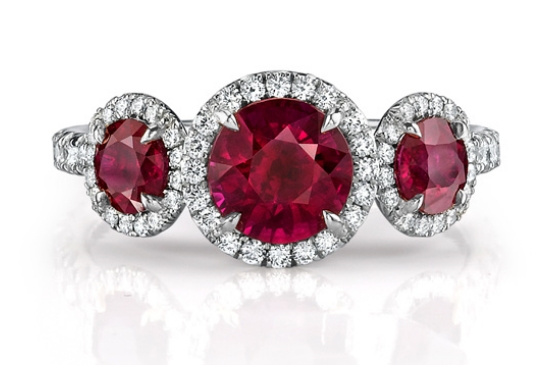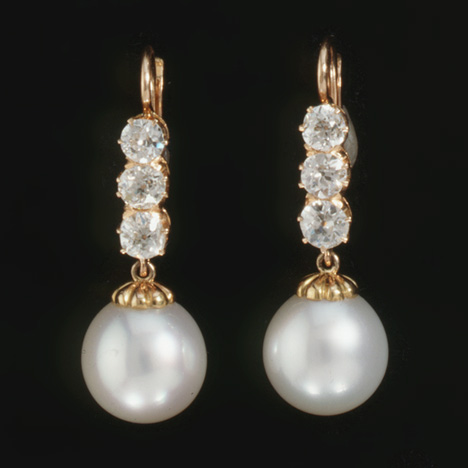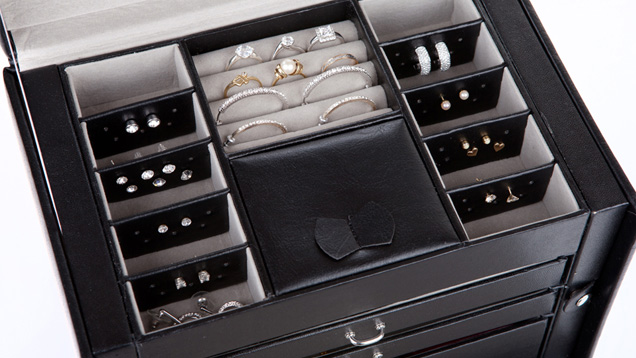
Careful cleaning and caring for your jewelry means you will enjoy its beauty forever. Courtesy of Omi Privé.
Jewelry is one of our most intimate and cherished accessories. Understanding how to care for and protect your treasured jewelry can make a world of difference in maintaining its beauty and keeping your heirlooms sparkling for generations to come.
BE CAREFUL WITH LIGHT AND HEAT
Just as the sun’s harmful rays can damage our skin, light and heat can affect a colored gemstone’s durability and color. Over time, and in excess, they can also fade or damage some gemstones, such as amethyst, kunzite, topaz and shell cameos. Pearls and other delicate materials, such as ivory, will bleach under extreme exposure to light. Other gems, especially amber, can darken over time when exposed to too much light.
Excessive heat and sudden temperature changes may also fracture some gems. Heat can easily remove the natural moisture these gems need to keep their beauty. Pearls, for instance, can dry out, crack and discolor. Opals can turn white or brown, develop tiny cracks, and might lose their play-of-color.

Vintage jewelry, such as this French 18K yellow gold and diamond feather brooch, circa 1860, should be handled delicately and can be cleaned with just water and a soft, lint-free cloth. Photo by David Behl, © Janet Mavec & GIA.
KEEP YOUR JEWELRY AWAY FROM CHEMICALS
Exposure to chemicals can damage or discolor precious metals – gold, silver and platinum – and may harm some colored gems. Even everyday substances like hairspray, lotion, perfume or other cosmetics can contain chemicals that will permanently damage the surface of your pearls and other delicate or porous gems (like turquoise). Fine jewelry should be removed before diving into a chlorinated swimming pool or before using household cleaners. Many of these cleaners contain ammonia, which can be too harsh for delicate gems or vintage jewelry. Chlorine bleach, another common household solvent, can pit or damage gold alloys.
GIVE TREATED GEMS SPECIAL CARE
Many colored gemstones are routinely treated to improve the appearance of color and clarity. These treatments can be negatively affected by heat, solvents, steam and ultrasonic cleaners. Knowing whether your gem has been treated is the first step to knowing how to care for it. This is where a GIA report comes in – it contains important information about your gem and any detectable treatments it may have undergone.
USE ULTRASONIC CLEANERS WITH CAUTION
While you can purchase a professional ultrasonic cleaner for $150 or less, you should be aware that not all gems and jewelry can be safely cleaned in it.
Ultrasonic cleaners should not be used to clean:
• Gemstones with surface-reaching breaks that have been filled with a substance such as oil, resin or a glass-like material
• Organic gem materials such as pearls, coral, ivory, or amber
• Gems that have been coated with a non-permanent substance like plastic or wax
• Some heat-treated gemstones
• Gems that are susceptible to heat and temperature changes whether they are treated or not. Some of these gems include tanzanite, feldspar (sunstone and moonstone), fluorite, iolite, kunzite, lapis lazuli, malachite, opal, topaz, turquoise, zircon and others
What’s more, the vibration generated by the machine can sometimes shake gems loose or chip gems that are set with their girdles touching.
This type of cleaning is best left to jewelry professionals who know about different gem materials and understand when and how to use the ultrasonic cleaner safely.
THE SAFEST CLEANING METHODS ARE ALSO THE EASIEST
Most colored gems can be cleaned with warm water, mild dish soap (no detergents) and a soft brush. A pulsed-water dental cleaning appliance and a soft, lint-free cloth can also be used. Be sure to rinse your jewelry in a glass of water to remove cleaning solutions since you risk losing loose stones – or even an entire piece of jewelry - if you rinse directly in the sink.
Soft gems, such as pearls, on the other hand, can easily scratch. Use a new, clean makeup brush and warm, soapy water to softly clean them. Lay a strand of pearls on a towel to dry. The wet silk thread can stretch − and attract dirt − so don’t touch your strand until it is completely dry. Pearls worn often should be restrung once a year

Pearl earrings, such as these American 14K gold, diamond and cultured pearl earrings, should be cleaned using an unused makeup brush and warm, soapy water. Photo by David Behl, © Janet Mavec & GIA.
SAFELY STORE YOUR JEWELRY
Proper jewelry storage is often overlooked. Jewelry should never be tossed into a drawer or on top of a dresser − that’s asking for scratches and damaged gems.
Most jewelry pieces come in a box or pouch from the store, which is a perfect place to keep them. Sterling silver, for example, should be kept in an anti-tarnish bag or cloth. Jewelry boxes that feature individually padded slots for rings and posts for hanging necklaces and bracelets are also ideal.

Each container can hold one type of jewelry − earrings, rings, necklaces, bracelets and watches. Keeping like items together is practical to have every option available when selecting what you want to wear.
Pearls and opals draw moisture from the air, so storing your opal or pearl jewelry in a dry area, such as a safe deposit box, can sometimes do more harm than good.
When traveling, protect your jewelry pieces from scratches or other impact damage by padding it in a separate box or case.
Many jewelry stores offer free check-up or professional cleaning at scheduled intervals: Jewelry should be checked every six months and cleaned frequently. Look for a jeweler with professional training and a good reputation – asking friends or relatives for recommendations is a good place to start. GIA’s Retailer Lookup can help locate a jeweler in your area who has GIA trained associates on staff.



